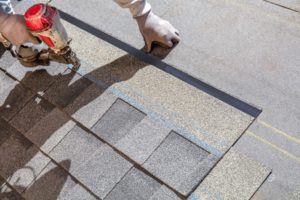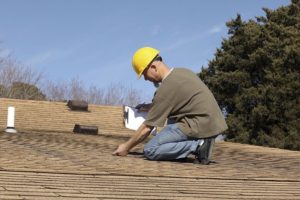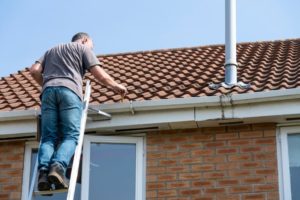Getting rid of mold and mildew from your roof and ensuring they stay off your roof is a worthy project to embark on because of the integral role your roof plays.
Your roof is among the most important part of your home you need to pay keen attention to, not only does it offer protection against elements, but it also provides structural support and security to your home.
Mold and mildew (when allowed to grow) can become a problem that can stop your roof from performing to its full capacity towards providing shelter and security to your home.
Mold and mildew retain moisture which can lead to roof leaks by creating gaps or holes in your roof. Over time, this can cause your roof to rot and can equally threaten the structural integrity of your roof leading to roof degradation.
It is also worthy to note that mold and mildew can cause health problems with prolonged exposure, as the mycotoxins they produce can cause mild to severe symptoms in humans.
It is better to get rid of mold and mildew from your roof now before it’s too late and cause more harm to you, your family, and your home.
In this post, you will learn what mold and mildew are, how mold and mildew got hold of your house, how to get rid of them, and finally, how to prevent and stop mold or mildew from growing in your roof (or simply put, how to get rid of mold and mildew from your roof).
This will give you the required knowledge you need to protect your house and health from the harmful effect of mold and mildew, ensuring your home is well secured.
Let’s dive in and share with you what you need to know.
What are Mold and Mildew?
Mold is a type of fungus that consists of organisms found almost everywhere. They grow in the form of black or green patches which penetrate beneath the surface of the affected material, (in this case, a roof). While mildew has flat growth that remains on the surface of the affected material and can be easily removed.
Since mold needs moisture to thrive, you’re more likely to see it grow in damp places such as the bathrooms, crawl spaces, basements, kitchens, and attics.
How Mold and Mildew Got Hold of your Roof
The most common reason why molds grow on your roof or in your attic is inadequate ventilation of the attic. When there is inadequate ventilation in the attic, the moist, hot air inside the attic creates a breeding ground for mold to grow which then attaches to the underside of the roof and begins to spread.
Rain and water infiltration from your roof is also another reason why mold grows on your roof or in your attic.
Why You Need To Get Rid of Mold and Mildew from Your House
Like we stated earlier, mold and mildew can be harmful to our health and also leads to the deterioration of your roof when allowed to stay longer.
Molds can lead to a serious health challenge, especially to people sensitive to mold or those that have serious health challenges like asthmatic patients, people suffering from liver disease or cancer.
For example, in people with asthma who are allergic to mold, breathing in a large number of mold spores can also lead to an asthmatic attack.
Another major reason why you need to get rid of mold and mildew from your house is to protect the integrity of your roof.
Mold and mildew thrive on moisture, and if your roof has a moisture problem it’s a signal that your roof has other serious problems such as roof leaks which can cause more severe damage to your roof and can lead to total roof replacement if not discovered earlier.
Now before we go ahead to discuss things you can do to prevent and stop mold and mildew from growing in your roof, let’s dissect the common breeding grounds for mold and mildew, so you will know what to look out for when trying to prevent or get rid of mold and mildew.
Common Breeding Grounds for Mold & Mildew
- Leaky flashings and shingles can encourage the growth of mold and mildew in your roof by allowing rain to infiltrate attics, eaves, insulation, and other areas that can trap moisture.
- Leaky air-conditioning duct joints create a moist environment that encourages the growth of mildew.
- Improperly flashed and caulked windows (and those with poor ventilation, airflow, and a large amount of surface condensation) allow moisture to seep into the surrounding wood, drywall, and insulation and can encourage the growth of mold and mildew in your roof.
- Humidifiers, especially reservoir-type central units, encourage the growth of mold and mildew, and also acts as a distribution system for mold and mildew.
- Poorly constructed crawlspaces encourage mildew growth.
- Poorly ventilated bathrooms allow surface mold to grow.
Now that you have known the common breeding grounds for mold and mildew, let’s go ahead and share with you how you can get rid of mold and mildew from your roof and also prevent them from resurfacing.
Things You Can Do To Prevent or Get Rid of Mold and Mildew Growth in Your Roof
There are various things you can do to stop the growth of mold and mildew on your roof and also prevent them from coming back. Mold and mildew can have an adverse effect on you and your house as it shortens the life expectancy of your roof and also endangers your health when exposed to a large number of spores for a longer period of time.
Here are the major things you can do to prevent and get rid of mold and mildew growth from your roof:
Reduce Moisture in your Home
The one thing all molds need most to thrive is moisture. Since mold spores can’t grow without moisture, reducing moisture in your home is a very effective way to prevent and get rid of mold and mildew growth from your roof and home in general.
Here are a few effective tips for reducing moisture in your home
- Use dehumidifiers: Dehumidifiers make your home less hospitable to allergens like mold and mildew, by reducing humidity levels.
- Reduce condensation by adding insulations to cold surfaces such as the exterior walls, floors, and windows.
- Ensure your attic is properly ventilated to avoid making it the perfect breeding place for mold.
Keep Your Roof Clean
Keeping your roof clean is one sure way to ensure mold and mildews are kept away from your roof. When your roof is cluttered with debris, it can lead to water clog on the roof or worst, roof leaks which will allow moisture into your roof and creates a thriving ground for the growth of mold and mildew.
You have to ensure you remove any chances of moisture sitting on your roof and you can do that by clearing the debris off your roof, ensuring your roof drainage system is in good shape. You might also need to trim your trees to avoid tree leaves and branches falling on your roof thereby creating more debris.
Repair Damaged Areas
Whether you have damaged or missing shingles on your roof, you need to ensure you fix that up as quickly as you can as they can allow water or moisture into your roof.
Apart from the fact that damaged roofing material can lead to water or moisture getting into your roof which can lead to mold growth, it also indicates that your roofing system has a weak link you need to pay attention to immediately.
Failure to repair minor roof damage in its early stage can lead to more severe damage where you have to spend more money to get it done.
Schedule a Roofing Inspection with a Professional Roofer
To properly assess the problem and uncover the hidden damages on your roof, you need to call a roofer to perform a thorough inspection of your roof.
This is because you might not detect the growth of mold or mildew in your roof in its early stage, which can create a major problem for you along the line, but having a professional roofer occasionally inspects your roof will help you detect these problems on time and get rid of them as quickly as possible.
Discover how to get the best roofing contractors to determine the extent of your roofing problem and the best method to fix it.
Conclusion
Learning how to get rid of mold and mildew from your roof is a necessary step for every homeowner, as it helps you to avert the health and roofing problems that are caused by the growth of mold and mildew in your house.
Problems with moisture and water on your roof are among the most serious roofing problems you will encounter as a homeowner and you need to repair it as quickly as possible, as it can lead to more severe roof damages which can be costly to repair and in most cases will require a new roof.
You don’t need to see the growth of mold or mildew in your roof before you decide to repair a damaged roofing material. Taking proactive steps is the best way to preserve your roof and ensure it reaches its life expectancy.






